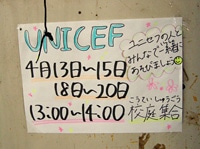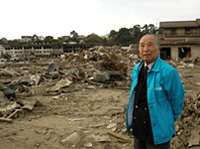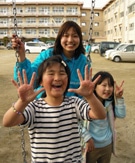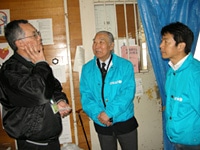



[TOKYO, Japan, 19 April 2011]
On 18 April, Representative Director and Vice-Chairman for the Japanese Committee for UNICEF (JCU) Yoshihisa Togo visited Kama Primary School in Ishinomaki City, Miyagi Prefecture, where JCU has been conducting assistance activities. There, Mr. Togo heard directly from the disaster victims.
At Kama Primary School there are still approximately 200 people, including children, staying in the shelter. Since the earthquake JCU has been operating Child Friendly Spaces at 10 different shelters in Miyagi Prefecture, including Kama Primary School.
 |
 |
|
| © Japan Committee for UNICEF | © Japan Committee for UNICEF | |
| A poster advertising Child Friendly Spaces. | JCU Representative Director/Vice-Chairman Yoshihisa Togo standing in front of a damaged primary school. |
 |
| © Japan Committee for UNICEF |
| A damaged school in Yuriage, Natori City. |
On the day of Mr. Togo’s visit, a Child Friendly Space was opened in the schoolyard and children staying at Kama Primary School gathered around to play. The space was filled with student volunteers wearing blue UNICEF t-shirts who played with children using flags from the UNICEF recreation kits, built blocks and ran around the schoolyard.
Nevertheless, the schoolyard is still covered with cars and rubble that were flushed into the area as a result of the disaster, so the children are not able to play as freely as they normally would. For children, playing is the most important part of life. Due to these circumstances, since the earthquake JCU has been working hard to establish a Child Friendly Space in Kama Primary School’s gymnasium and provide a place where children can play freely and comfortably in order to relive the stress caused by the earthquake and extend psychological assistance to the children.
 |
| © Japan Committee for UNICEF |
| (From left) Principal Tsuda, JCU Representative Director/Vice-Chairman Togo and Dr. Kunii. |
Kama Primary School is scheduled to reopen on 21 April, but there are still people staying in the gymnasium that will be forced to continue doing so because their homes have been flooded, destroyed or are unusable for other reasons. There were even some disaster victims that spoke with Mr. Togo that told him about how they had lost their entire families.
Mitsugu Akiyama’s home was located in Tsukiyama, Ishinomaki City, and was completely destroyed by the earthquake disaster. It took two entire weeks for Mr. Akiyama, who is a staff member on a tanker ship, to reconnect and confirm the safety of his wife Mika and two sons, Shoya (12) and Koki (10). “I like funny comics,” says Shoya, who will start his first year in junior high school from this spring. He says he hopes to see his friends soon, showing how excited he is for his school to reopen.
Working towards the reopening of the school on 21 April, Hiroshi Tsuda, the school principal, says that, “The school and shelter will work together as they operate in concert on the same school grounds.” Electricity has yet to be restored at Kama Primary School, so the dual operations will require innovative responses to such issues, such as switching electricity use back and forth between the shelter and school.
Mr. Togo says that he will never forget Mr. Akiyama’s enthusiastic handshake. “As long as you are alive, you can build a tomorrow for yourself. I plan to help in creating a future for children like Shoya and Koki,” he says.
JCU will continue working together with the boards of education, municipal governments and other partner organizations to promote assistance activities in all cities in Miyagi Prefecture so that children can return to school as soon as possible.
| Receiving Prefecture |
Type of Emergency Supplies |
Arrival Date |
Quantity | Donating Company |
Comments |
|---|---|---|---|---|---|
| Miyagi | Water | 19 Mar. | 12,288 bottles |
VanaH Co., Ltd. | Two-liter plastic bottles |
| Fukushima | Water | 22 Mar. | 12,672 bottles |
VanaH Co., Ltd. | Two-liter plastic bottles |
| Miyagi | Underwear for boys and girls | 22 Mar. | 200,000 | ||
| Iwate | Underwear for boys and girls | 23 Mar. | 30,000 | ||
| Fukushima | Water | 23 Mar. | 4,680 bottles |
KIRIN MC DANONE WATERS Co., Ltd. | Two-liter plastic bottles |
| Miyagi | Children’s shoes | 23 Mar. | 10,000 pairs |
||
| Miyagi | RChildren’s diapers | 24 Mar. | 80 packs | P&G Japan | |
| Iwate | Children’s underwear | 24 Mar. | 9,700 | ||
| Fukushima | Water | 24 Mar. | 12,288 bottles |
VanaH Co., Ltd. | Two-liter plastic bottles |
| Iwate | Shoes | 26 Mar | 1,404 pairs | Achilles Corporation | |
| Iwate | Underwear for boys and girls | 27 Mar. | 28,266 | ||
| Iwate | Boots | 27 Mar. | 7,462 pairs | ||
| Iwate | Wipes | 28 Mar. | 1,200 | P&G Japan | For babies |
| Miyagi | Recreation kits Early Childhood Development kits |
2 Apr. | 50 of each | Procured from the UNICEF Supply Division | |
| Iwate | Recreation kits Early Childhood Development kits |
2 Apr. | 50 of each | Procured from the UNICEF Supply Division | |
| Miyagi | Book bags | 6 Apr. | 70 | Nihon New Bag Chain | |
| Iwate | Book bags | 6 Apr. | 340 | Seiban | |
| Miyagi | Schoolbags | 8 Apr. | 18,000 | Procured from the UNICEF Supply Division | |
| Iwate | Schoolbags | 8 Apr. | 18,000 | Procured from the UNICEF Supply Division | |
| Miyagi | Personal security buzzers (for crime prevention purposes) | 8 Apr. | 5,000 | ||
| Iwate | Personal security buzzers (for crime prevention purposes) | 8 Apr. | 5,000 | ||
| Fukushima | Water | 11 Apr. | 1,536 bottles | VanaH Co., Ltd. | Two-liter plastic bottles |
| Miyagi | Replenishments for recreation kits | 12 Apr. | 60 sets | ||
| Miyagi | Miniature toy cars | 12 Apr. | Approx. 1,200 | TAKARA TOMY | |
| Sagamihara* | Water | 12 Apr. | 12,288 bottles | VanaH Co., Ltd. | Two-liter plastic bottles |
| Miyagi | Play mats | 13 Apr. | Two types; 80 of each type | IKEA | |
| Miyagi | Drawing sets | 13 Apr. | 60 sets | IKEA | |
| Iwate | Chairs (for 3-5 year olds) | 14 Apr. | 75 | ||
| Iwate | Tables (for 6 people) | 14 Apr. | 11 | ||
| Iwate | Low tables | 14 Apr. | 9 |
*Areas receiving disaster victims.
*In certain cases some supplies may be taken from prefectural supply storage warehouses and distributed to shelters and disaster sites in other prefectures.
As of 9:00 a.m. on 15 April 2011 (compiled by the Information and Public Affairs Division).